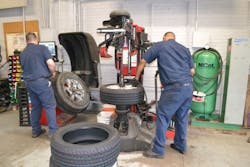Anyone who has worked in the tire and automotive repair business for even a week will be familiar with metrics - important financial and operational milestones or ratios used to evaluate how efficiently and profitably a store is run.
Some individual metrics can stand alone. For example, on average, for every four retail tires sold, there should be an alignment sold or for every four oil changes sold, there should be an air filter sold.
These metrics are based on simple wear-out trends of the product or maintenance intervals. They have been around for ages. It’s not selling skills. It’s show and tell.
Some metrics need support and only make sense in combination with other metrics. Take, for example, a net profit percent (or return on sales) of 10%. As a reminder, a store with a return on sales of 10% can be explained using the maxim that every sales dollar produced by the store should result in 10 cents of net profit.
This is a gold standard in our industry, as the average store only returns two or three cents per dollar sold. But this number is meaningless without support.
In order to even have a chance at achieving 10% net profit, the store must be operating at 60% gross profit, and in addition to that, must also be at least 50% tire sales and 50% service sales. Expenses also must be managed correctly. You can’t just “manage to" 10% net. You manage the other metrics and they produce the net profit percentage.
Additionally, there is the sheer volume of how many metrics can you meaningfully track every month. At some point, you risk analysis paralysis. It can get complicated real fast if you let it.
This month, I’d like to tackle some myths about a much-maligned metric, the average repair order (ARO.)
The ARO, mathematically, is the total number of sales divided by total vehicle or ticket count.
You can separate business by type; if you like: retail, national account, commercial, etc. It depends on your core business.
Conventional wisdom says that if you increase ARO, sales will go up. Makes sense. But then you start to hear things like, “If we just sell one more bulb on every car, that’s $10 more per car, which is $5,000 more a month and $60,000 a year!” or “If we sell just three more flushes a day…”
You get the gist. You probably hear it every week.
While mathematically true that this will increase sales, it is not valuable to think that way in practice. For starters, it makes sales advisors focus on selling specific services for their benefit - which sometimes, can be the benefit of not getting into trouble.
This is a dangerous path as recommendations should always be done for the customer’s benefit. Sales should satisfy customer needs at a profit that benefits the company.
Metrics like ARO and return on sales are meant to propose a question: Why isn’t the business doing what is natural?
It is not meant to direct a particular action, like selling more bulbs. Nor is the answer to a low return, "Let's increase sales and see what happens."
It’s meant to alert management that something is wrong and the business isn’t profiting properly on its sales.
It also begs for an answer to the question, “What functionality within our operation is broken and preventing optimal profit from happening?”
ARO is a result of other things happening correctly. It’s not a thing that stands alone. If your ARO is not good, you must explore why.
The national average ticket for tire and automotive repair stores is in the ballpark of $260. If you are at $250 or $270, you are doing it right and there’s no need to over-analyze. If you are not around $260 per ticket, on average, then explore why. It could be:
-
Your people are not mentioning courtesy inspections at the counter. (Surprise inspection results rarely convert to sales);
-
Lack of inspections or poor inspections performed by your technicians and lube/tire techs;
-
Sales advisors not delivering the news on inspections;
-
Lack of finance options offered to customers;
-
Your advertising;
-
Your hours of operation and other factors.
A well-run dealership will have a healthy mix of low-dollar tickets, which focus on fast services, like flat repairs and oil changes - in other words, on-demand stuff. It also will have a healthy dose of heavy repairs and expensive four-tires-and-alignment-type tickets.
Both types of tickets are good for your business.
When it comes to measuring your dealership’s success, some metrics are really easy, “plug-and-play” ones, which are usually part of the process. Others take some digging in and solving. These are usually end result metrics that are built on top of process metrics.
Dennis McCarron is a partner at Cardinal Brokers, one of the leading brokers in the tire and automotive industry (www.cardinalbrokers.com). To contact McCarron, email him at [email protected].


